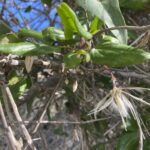Λιλλιτζιά, Κλώστρος, Αρκόκλημα, Κληματίδα η κιρρώδης
Etymology of Clematis cirrhosa: "Clematis" comes from the Ancient Greek "κληματίδα" which means "clematis, vine, climbing plant, bower" because it grows and spreads as the vine. Latin "cirrhosa" is derived from the Greek "κιρρός" [kirros] meaning ''yellowish, blondish'' referring to the flower colour.
There are at least two Clematis species in Cyprus and Clematis vitalba is the only one that is naturalized, but non-invasive. A third species, Clematis viticella, has not been recorded since 1977 when Meikle traced it at an altitude of 1300 metres on the Troodos Mountains range and it may have extinct.
Clematis cirrhosa is an evergreen climbing shrub, native species of Cyprus. In height, it reaches up to about 5 meters. It has long shoots of brown to reddish color, leaves simple or trifoliate, stems sinuous, flowers abundant, white, hermaphrodite, hanging, bell-like, with four horseshoe-shaped pale yellow sepals.
It is a cosmetic plant and thrives on all kinds of soils. It is found even in the lowlands, up to an altitude of 900 meters, but primarily it is found in forest areas, in the regions of Akamas, Karpasia, Cape Greco, Troodos and in the Pentadaktylos mountains. In forest areas, it is also found climbing on tree trunks. It blooms between December and March.

